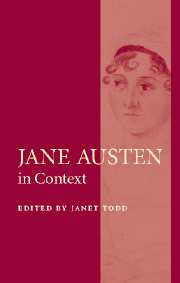3 - Language
Published online by Cambridge University Press: 19 December 2020
Summary
In an unsigned review of Emma published in 1816, Walter Scott draws particular attention to the domestic realism of the novel’s anonymous author, whose fiction he perceives as bearing ‘the same relation to that of the sentimental and romantic cast, that cornfields and cottages and meadows bear to the highly adorned grounds of a show mansion, or the rugged sublimities of a mountain landscape’. If this delineation of Jane Austen's style seems commensurate with the author's own often-quoted opinion of her work – ‘the little bit (two Inches wide) of Ivory on which I work with so fine a brush’ (L, 16–17 December 1816) – it also damns her with faint praise. Scott locates her work as part of a new class of fiction that replaces the grandness of the earlier romance forms with ‘the art of copying from nature as she really exists in the common walks of life’ and ‘a correct and striking representation of that which is daily taking place’ (Quarterly Review, p. 192). The lexicon employed by Scott to define Austen's style is a restricted and feminised one: the story has ‘a simple plan’, and ‘[t]he subjects are not often elegant, and certainly never grand’, while the author's merit ‘consists much in the force of a narrative conducted with much neatness and point, and a quiet yet comic dialogue’ (Quarterly Review, pp. 197, 199, my emphases).
This interpretation, while acknowledging the subtlety of Austen's style, occludes much of the vibrancy and range that her works also evidence. One need only read her Juvenilia in order to be struck by the rich and dynamic language that is natural to Austen, and which is rendered only in more nuanced terms in her mature writings. The subject matter of these early writings – illegitimacy, alcoholism, gambling, theft, violence and murder – is reflected in the raw, unmediated language. ‘Henry and Eliza’ is typical: ‘Sir George and Lady Harcourt were superintending the Labours of their Haymakers, rewarding the industry of some by smiles of approbation, & punishing the idleness of others, by a cudgel.’ Here, the balanced syntax typical of eighteenth-century prosody (rewarding industry/punishing idleness) is juxtaposed with absurd couplings (smiles of approbation/a cudgel).
- Type
- Chapter
- Information
- Jane Austen in Context , pp. 23 - 32Publisher: Cambridge University PressPrint publication year: 2005
- 4
- Cited by



